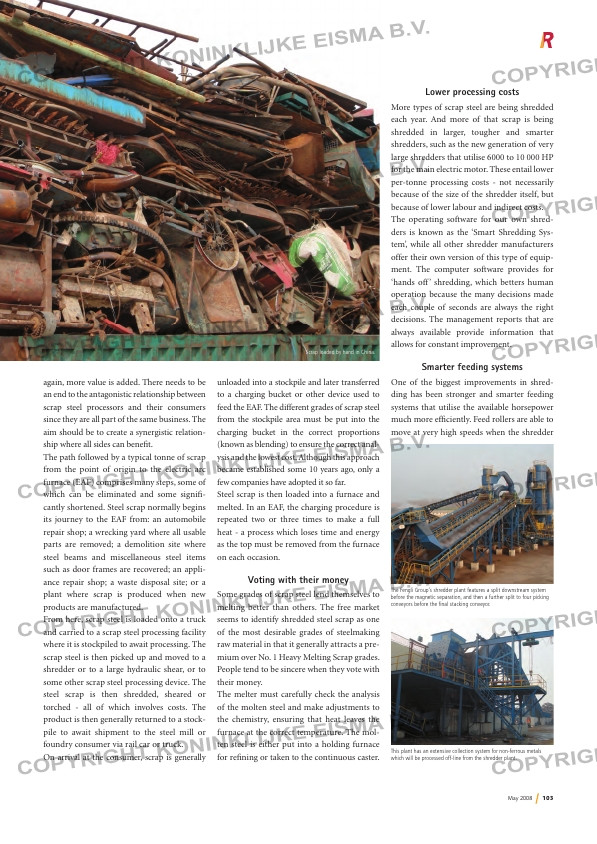Page 103 from: May 2008

May 2008 103
again, more value is added. There needs to be
an end to the antagonistic relationship between
scrap steel processors and their consumers
since they are all part of the same business. The
aim should be to create a synergistic relation-
ship where all sides can benefi t.
The path followed by a typical tonne of scrap
from the point of origin to the electric arc
furnace (EAF) comprises many steps, some of
which can be eliminated and some signifi –
cantly shortened. Steel scrap normally begins
its journey to the EAF from: an automobile
repair shop; a wrecking yard where all usable
parts are removed; a demolition site where
steel beams and miscellaneous steel items
such as door frames are recovered; an appli-
ance repair shop; a waste disposal site; or a
plant where scrap is produced when new
products are manufactured.
From here, scrap steel is loaded onto a truck
and carried to a scrap steel processing facility
where it is stockpiled to await processing. The
scrap steel is then picked up and moved to a
shredder or to a large hydraulic shear, or to
some other scrap steel processing device. The
steel scrap is then shredded, sheared or
torched – all of which involves costs. The
product is then generally returned to a stock-
pile to await shipment to the steel mill or
foundry consumer via rail car or truck.
On arrival at the consumer, scrap is generally
unloaded into a stockpile and later transferred
to a charging bucket or other device used to
feed the EAF. The different grades of scrap steel
from the stockpile area must be put into the
charging bucket in the correct proportions
(known as blending) to ensure the correct anal-
ysis and the lowest cost. Although this approach
became established some 10 years ago, only a
few companies have adopted it so far.
Steel scrap is then loaded into a furnace and
melted. In an EAF, the charging procedure is
repeated two or three times to make a full
heat – a process which loses time and energy
as the top must be removed from the furnace
on each occasion.
Voting with their money
Some grades of scrap steel lend themselves to
melting better than others. The free market
seems to identify shredded steel scrap as one
of the most desirable grades of steelmaking
raw material in that it generally attracts a pre-
mium over No. 1 Heavy Melting Scrap grades.
People tend to be sincere when they vote with
their money.
The melter must carefully check the analysis
of the molten steel and make adjustments to
the chemistry, ensuring that heat leaves the
furnace at the correct temperature. The mol-
ten steel is either put into a holding furnace
for refi ning or taken to the continuous caster.
Lower processing costs
More types of scrap steel are being shredded
each year. And more of that scrap is being
shredded in larger, tougher and smarter
shredders, such as the new generation of very
large shredders that utilise 6000 to 10 000 HP
for the main electric motor. These entail lower
per-tonne processing costs – not necessarily
because of the size of the shredder itself, but
because of lower labour and indirect costs.
The operating software for our own shred-
ders is known as the ‘Smart Shredding Sys-
tem’, while all other shredder manufacturers
offer their own version of this type of equip-
ment. The computer software provides for
‘hands off ’ shredding, which betters human
operation because the many decisions made
each couple of seconds are always the right
decisions. The management reports that are
always available provide information that
allows for constant improvement.
Smarter feeding systems
One of the biggest improvements in shred-
ding has been stronger and smarter feeding
systems that utilise the available horsepower
much more effi ciently. Feed rollers are able to
move at very high speeds when the shredder
This plant has an extensive collection system for non-ferrous metals
which will be processed off-line from the shredder plant.
The Fengli Group’s shredder plant features a split downstream system
before the magnetic separation, and then a further split to four picking
conveyors before the fi nal stacking conveyor.
Scrap loaded by hand in China.
RI_061_Shredded Scrap.indd 3 15-05-2008 08:57:06



